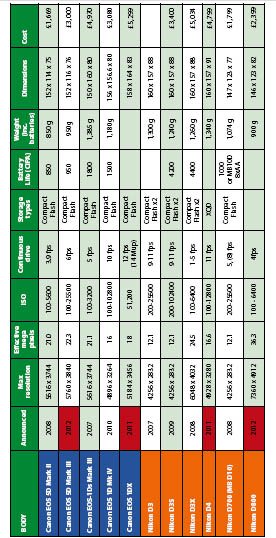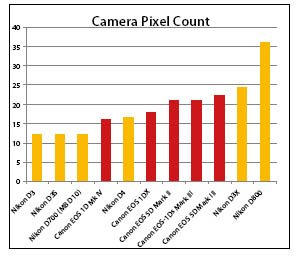articles/Cameras/dslrchoices-page2
DSLR - choices? - part 2 of 1 2 3
Published 01/06/2012

This performance was built on the back of a relatively modest pixel count, each pixel with a larger surface area for gathering photons. At 6400 ISO, the images remained usable up to A2 (depending upon your point of view!). Now the D800, with its mouth-watering 36.3 mega pixels must surely have compromised a bit on high ISO settings, but for the GP and studio photographer it offers medium-format levels of file sizes. Such power is also attractive to the landscape and architectural photographer who would ordinarily be working off a tripod and cares little for high ISO settings anyway. So the dilemma is - a D4, a D800 or both?
There is also the cost difference to consider. It is impossible to put a universal metric on the value of a particular feature. How do you value pixels, ISO rating, GPS facilities, movie capabilities or framing rate? The only people who do not have a problem are the sports guys - the D4 is an out and out speed merchant, built like a brick and a waterproof one at that - simples! Despite the nonsense of finding a true metric we have at least had a go. If nothing else the graphs point up what does what, and for how much. They are interesting in that they show just how far out on its own the D800 is; no other camera occupies the same part of the territory and it represents massive value for money in terms of pixels lone.

The charts and graphs are useful only in getting things into some form of order. It is highly unlikely that a marque choice will be made on this basis (although some Canon owners might be longingly looking into the Nikon garden, wondering why they cannot have so many pixels!). In truth people are generally entrenched in one system or another and reluctant to move away from their investment in glassware and flash guns.
Please Note:
There is more than one page for this Article.
You are currently on page 2
1st Published 01/06/2012
last update 21/07/2022 08:46:24
More Cameras Articles
There are 30 days to get ready for The Society of Photographers Convention and Trade Show at The Novotel London West, Hammersmith ...
which starts on Wednesday 14th January 2026










